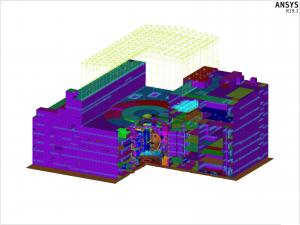Collaborer pour maintenir ITER sur ses fondations
« Participer à la définition des charges sismiques n'est que l'une de nos activités, explique Tyge Schioler, le responsable de la Section analyse technique intégrée, dont la mission générale est de contribuer à définir les charges de toute nature qui agissent sur l'installation. Nous faisons de même pour les champs électromagnétiques statiques ou les charges électromagnétiques transitoires en cas de perturbations, et nous aidons également à déterminer les charges thermiques au cours d'événements transitoires. »
« Nous offrons des conseils et un appui en matière de méthodologie et de bonnes pratiques d'analyse. Nous rédigeons des documents expliquant, par exemple, comment réaliser une analyse et nous fournissons également un soutien direct lorsqu'un concepteur est confronté à un problème spécifique. Nous formulons alors des recommandations ponctuelles. »
Pour faciliter l'analyse des charges sismiques, les équipes d'ITER et de l'agence domestique européenne Fusion for Energy utilisent le progiciel ANSYS pour établir des modèles à éléments finis reliant l'accélération aux fréquences naturelles d'une structure donnée. La fréquence d'une structure est une fonction de la masse et de la rigidité, dans laquelle la rigidité est une propriété définie par l'amplitude du déplacement d'un objet lorsqu'une force donnée lui est appliquée. Plus le déplacement est faible, plus la structure est dite « rigide ».
« Lorsqu'une structure n'est constituée que d'acier et de béton, la modélisation est simple, constate Schioler. La plupart des structures sont toutefois constituées de différents matériaux, et nos modèles doivent prendre en compte cette hétérogénéité. Notre modèle le plus complexe est celui du tokamak ITER et du Complexe tokamak pris dans leur ensemble. »
Modèle de référence des charges sismiques dans le Complexe tokamak
Sans surprise, une grande partie de l'analyse sismique porte sur la définition des charges dans le Complexe tokamak, incluant les Bâtiments tritium et diagnostic, ainsi que dans le Bâtiment tokamak lui-même. Ces bâtiments reposent sur des patins antisismiques qui isolent la structure horizontalement. Ces patins sont très rigides verticalement, ce qui implique que si le sol devait bouger verticalement, le bâtiment suivrait le mouvement. Par contre, l'élastomère composant les patins assure une flexibilité horizontale.
En cas de déplacement horizontal du sol, le bâtiment demeurerait relativement stable et l'équipement qu'il contient ne subirait qu'une très légère accélération.
« La déformation interne des structures des bâtiments est relativement peu importante, précise Schioler. En cas de séisme horizontal, les patins antisismiques absorberaient la majeure partie de la déformation. En fin de compte, le bâtiment n'est qu'un bloc rigide posé sur les patins. »
Malgré cela, l'équipement installé dans les bâtiments doit être conçu pour résister à n'importe quel mouvement. Chaque pièce d'équipement se comportant différemment des autres en fonction de sa fréquence naturelle, les fabricants ont besoin d'informations pour répondre aux exigences de sécurité et fiabilité.
La base de référence pour les charges sismiques a été constituée en 2016 dans le cadre d'une collaboration entre ITER, Fusion for Energy et certains de ses prestataires. « L'élaboration des modèles et le passage à travers l'ensemble des processus d'assurance qualité ont nécessité un travail colossal, explique Schioler. Nous avons décrit la manière dont chaque partie du bâtiment peut bouger durant un séisme et nous avons défini ce qu'on appelle les spectres de plancher transférés (des graphiques de l'accélération en fonction de la fréquence). Ces graphiques sont communiqués aux fabricants des équipements pour leur indiquer l'accélération qui doit être prise en compte dans la conception des pompes, vannes, cellules et autres composants qui doivent être installés à un emplacement donné sur un plancher donné. »
Les équipes utilisent également des modèles pour définir les déplacements relatifs entre différents points. Par exemple, la chambre à vide pourrait monter et descendre légèrement, tout comme, mais dans une moindre mesure, le bâtiment. Le mouvement relatif pourrait fragiliser un élément de tuyauterie installé entre les deux structures. Pour prévoir la façon dont un tuyau se déformera, les modèles ne peuvent se contenter des seules données du mouvement relatif, il leur faut également disposer d'informations sur la fréquence naturelle propre au tuyau.
Pour Schioler, « déterminer si le tuyau résistera ou non peut s'avérer une tâche assez complexe ».
Une journée type
« Typiquement, nous conseillons les responsables des équipements sur la façon d'interpréter et d'appliquer les charges de référence, il ajoute. Nous fournissons également des conseils sur la méthodologie d'analyse ainsi que sur les différentes manières d'effectuer les calculs. Lorsque quelqu'un souhaite sous-traiter une tâche, nous pouvons l'aider à rédiger les spécifications techniques pour veiller à ce que leurs besoins soient correctement exprimés. »
La Section analyses techniques intégrées dispense également des conseils pour le choix des codes et normes ainsi que pour la sélection des matériels, y compris pour les essais non destructifs des joints et soudures. Dans certains cas, la qualification de l'équipement est trop complexe pour s'appuyer uniquement sur des calculs. Des expériences doivent alors être réalisées — par exemple, la réaction d'un moteur peut être testée en plaçant celui-ci sur un plateau vibrant simulant un séisme.
« Plus important encore, il nous revient de quantifier le niveau de sécurité des bâtiments et équipements et nous nous appuyons pour cela sur des partenariats étroits. Fusion for Energy est responsable de la conception de la structure de génie civil. Nous suivons de près leur travail et effectuons des calculs en parallèle pour nous assurer que nous parvenons bien aux mêmes conclusions. Ensemble, nous devons réaliser une évaluation globale du bâtiment réacteur, d'un poids de 300 000 tonnes, et vérifier que chaque fragment de béton armé qui le constitue résistera à un séisme. »
« Il s'agit là d'un excellent exemple de collaboration réussie entre ITER, Fusion for Energy et certains de ses prestataires, conclut Schioler. Nous avons confiance dans leur travail, ils ont confiance dans le nôtre. Nous nous appuyons sur eux. Nous sommes en communication constante et nous nous assurons que nous travaillons ensemble de manière optimale. »


